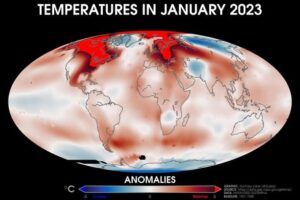Several devasting reports have been published these past few months outlining how the climate will change over the coming years and what this means for the planet as we know it. From exceeding global warming by 1.5°C as early as 2030 to ice sheets in Greenland losing more than three times as much ice as 30 years ago, there is a lot to be concerned about. The First World Climate Conference was held in 1979 in Geneva, at this time atmospheric CO2 was recorded at 337.10 ppm. Since this first conference, global warming and climate change have only intensified, resulting in the extreme climate crisis we face today. Climate predictions rely on evidence of how the climate has changed in recent history. As we reach the halfway mark of 2023, let’s see how the climate has changed so far this year.
 One of the best ways to measure how the climate has changed is through atmospheric CO2 ppm, which is the concentration of carbon dioxide in the Earth’s atmosphere. It is measured by the NOAA at an observatory at Mauna Loa. The first measurement ever taken was in 1958 at 313 ppm. On January 1st, 2023, 419.32 ppm was recorded, this is 1.85 ppm higher than at the beginning of 2022. In April, a record 423.3 ppm was documented, 10 years ago April averaged 399 ppm. The most recent recording was 424.26 ppm, this is 4.44 ppm higher than this time last year. This is a new record high for weekly CO2, these records are being broken almost on a weekly basis.
One of the best ways to measure how the climate has changed is through atmospheric CO2 ppm, which is the concentration of carbon dioxide in the Earth’s atmosphere. It is measured by the NOAA at an observatory at Mauna Loa. The first measurement ever taken was in 1958 at 313 ppm. On January 1st, 2023, 419.32 ppm was recorded, this is 1.85 ppm higher than at the beginning of 2022. In April, a record 423.3 ppm was documented, 10 years ago April averaged 399 ppm. The most recent recording was 424.26 ppm, this is 4.44 ppm higher than this time last year. This is a new record high for weekly CO2, these records are being broken almost on a weekly basis.
 Temperature measurements are another great indicator of climate change. The global mean temperature despite monthly variability is consistently near/above 1°C higher than 1850-1900 levels. We kickstarted the year with an average January global air temperature of +0.87 °C above the 1951-1980 climate baseline (+1.19°C above the 1880-1920 baseline). April was statistically tied as the fourth warmest April on record globally. The graph demonstrates regions where the average temperature in the first quarter of the year was at or near a record high. The NCEI’s Global Annual Temperature Outlook is virtually certain (> 99.0%) that 2023 will rank among the 10 warmest years on record.
Temperature measurements are another great indicator of climate change. The global mean temperature despite monthly variability is consistently near/above 1°C higher than 1850-1900 levels. We kickstarted the year with an average January global air temperature of +0.87 °C above the 1951-1980 climate baseline (+1.19°C above the 1880-1920 baseline). April was statistically tied as the fourth warmest April on record globally. The graph demonstrates regions where the average temperature in the first quarter of the year was at or near a record high. The NCEI’s Global Annual Temperature Outlook is virtually certain (> 99.0%) that 2023 will rank among the 10 warmest years on record.
The total Arctic Sea ice volume ranked 2nd lowest on record for March, at 1,230,000 km² below the 1981-2010 average. Meanwhile, the total Arctic Sea ice volume averaged the 10th lowest on record for April. This is approximately 29% below the 1979 levels and 15% below the 1979-2022 average for April. Approximately 20,600 square kilometres 8,000 square miles) of sea ice was lost per day, with a total decrease of 690,000 square kilometres (266,000 square miles). Since 1979, 1.65 million square kilometres (637,000 square miles) of ice have been lost during April alone. This is roughly equivalent to twice the size of the Ukraine.
Numerous climate records are expected to be broken by the end of the year resulting in devasting effects globally. With forests worldwide shrinking at an alarming rate and over a quarter of the Amazon rainforest emitting more carbon than it absorbs we need to be extremely worried. We need to take the current state of the planet seriously and recognise that if we don’t, life will become increasingly difficult for us all, especially those who are most vulnerable.
The IPCC stated that “Without a strengthening of policies, global warming of 3.2 [2.2–3.5]°C is projected by 2100 (medium confidence)”. Until the necessary interventions take place and systemic changes take place, we will continue to break climate records. The Earth has incredible regenerative powers and if we work together, we can restore and protect our planet for generations to come.






